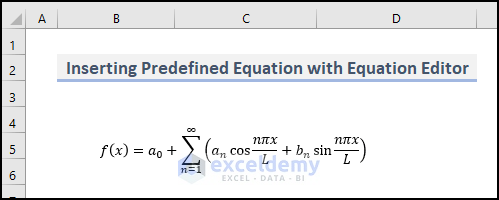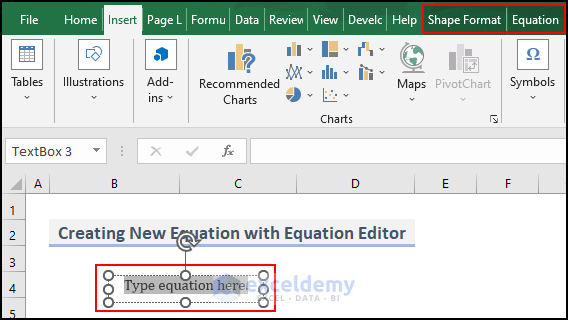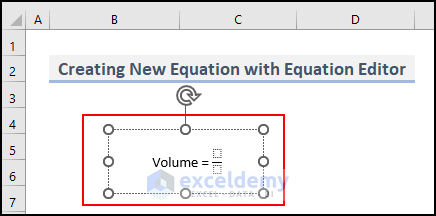Here’s an overview of the Equations Editor in a cell.

Download the Practice Workbook
What Is the Equation Editor in Excel?
Excel is used for calculating and presenting data, but sometimes it is necessary to display the underlying formulas. Excel lets you insert math equations as graphical objects using the Equation Editor. Users can create, edit, and display mathematical equations in their spreadsheets. The Equation Editor provides a user-friendly interface for entering complex mathematical expressions and formulas, making it easier for users to work with numbers.
How to Insert a Predefined Equation with Equation Editor in Excel
- Go to the Insert tab and click on Symbols.
- From the Symbols group, click on the Equation dropdown.

- A list of equations will appear. It includes:
- Area of Circle
- Binomial Theorem
- Expansion of a Sum
- Fourier Series
- Pythagorean Theorem
- Quadratic Formula
- Taylor Expansion
- Trig Identity 1
- Trig Identity 2
- Click on the equation that you need. We selected the equation of the Fourier Series.

- The equation will be inserted into the worksheet.

This way, you can insert a predefined equation in Excel using the Equation Editor.
How to Create a New Equation with the Equation Editor in Excel
Method 1 – Create a New Equation Using the Equation Command in Excel
We will make the Volume formula for a cylinder.

- Go to the Insert tab and click on Symbols.
- From the Symbols group, click on the Equation command.

- The Equation Editor appears.

- When the Equation Editor is selected, two contextual tabs appear in the tab list. They are Shape Format and Equation.
- The Equation Editor is a shape. You can format the shape using the Shape Format tab.
- The Equation contextual tab allows you to insert an equation in the Equation Editor.

- To write an equation in the Equation Editor, go to the Equation tab.
- You can see the Symbols and Structures sections. You can use these Symbols and Structures in the equation.
- Click on the More button (located in the bottom right corner of the Symbols window) to see more symbols.

- The window will be expanded.
- There is a drop-down in the top-right corner.
- You will see Basic Math symbols in the window.
- Click on the drop-down to see the other symbol options.

- If you select Greek Letters, you will get two types of Greek Letters: Lowercase Greek Letters and Uppercase Greek Letters.

- Select Geometry from the dropdown instead of Greek Letters. We can see the symbols like the screenshot below.

- There are also some structures inside the Equation tab.

- Type Volume in the Equation Editor.
- Type the equal sign (=).

- Click on the Fraction dropdown from the Structures group of commands.
- Select the Stacked Fraction.

- The Equation Editor will look like the image below.

- In the top blank box, type 1, and, in the bottom blank box, type 3.
- Press the right arrow on the keyboard.
- In the Symbols drop-down, select Basic Math and then the Multiplication Sign from the window.

- Go to Symbols then to Greek Letters and Lowercase and insert the Pi symbol.
- Select Basic Math and choose the Multiplication Sign.

- We need to insert ‘diameter/2’ whole square.
- Select the Superscript structure.

- Select the first blank box in the superscript.

- Insert Parentheses with a single value from the Bracket structure.

- The Equation Editor will look like the screenshot below. Select the box within parentheses.

- Click on the Stacked Fraction structure again.
- In the upper box, type Diameter.
- Type 2 in the bottom box.
- Type 2 as the superscript.
- Press the right arrow on the keyboard.
- Add a cross sign like the previous way and type Height.

- Our equation is complete like in the below image.

Method 2 – Insert an Equation in the Equation Editor Through the Ink Equation Tool
- Go to Insert tab and Equation, then select Ink Equation.

- A dialog box named Math Input Control will pop up.
- Sketch or draw the equation you need like in the image below. We have drawn the equation for the area of a circle.
- Make sure that Excel detects your drawing properly. If not, use the Erase option and Write again.
- Click on the Insert button.

- The final output will be like this:

How to Format an Equation in the Equation Editor+
- Select the equation and right-click on it.
- Increase the font size as per your choice.

- You can make the formula stay within a cell rather than move around as a floating object. To do this, right-click on the Text box and select the Format Shape option.

- Select the Size and Properties option.
- Mark Move and size with cells.

Read More: How to Insert Equation in Excel
Frequently Asked Questions
What is the equation in MS Excel?
Equations in Excel refer to a formula that performs calculations or operations on data in cells. Formulas are used to manipulate data and perform various calculations within the spreadsheet. Excel uses a formula syntax that starts with an equal sign (=) followed by the formula or function. To create an equation (formula) in Excel, you simply type it into the formula bar at the top of the Excel window or directly into a cell. When you press Enter, Excel will calculate the result of the formula and display it in the cell.
What kind of equations can I create with the Equation Editor in Excel?
The Equation Editor in Excel allows you to create various types of mathematical equations, including basic arithmetic operations (addition, subtraction, multiplication, division), fractions, exponents, radicals, integrals, Greek letters, and other advanced mathematical expressions. It supports a wide range of mathematical symbols and functions.
Can I use the Equation Editor to plot graphs or charts in Excel?
No, the Equation Editor in Excel is primarily designed for entering mathematical equations and expressions. It does not have built-in graphing capabilities. To plot graphs or charts in Excel, you’ll need to use the charting tools available in the “Insert” tab.
<< Go Back to Learn Excel
Get FREE Advanced Excel Exercises with Solutions!

